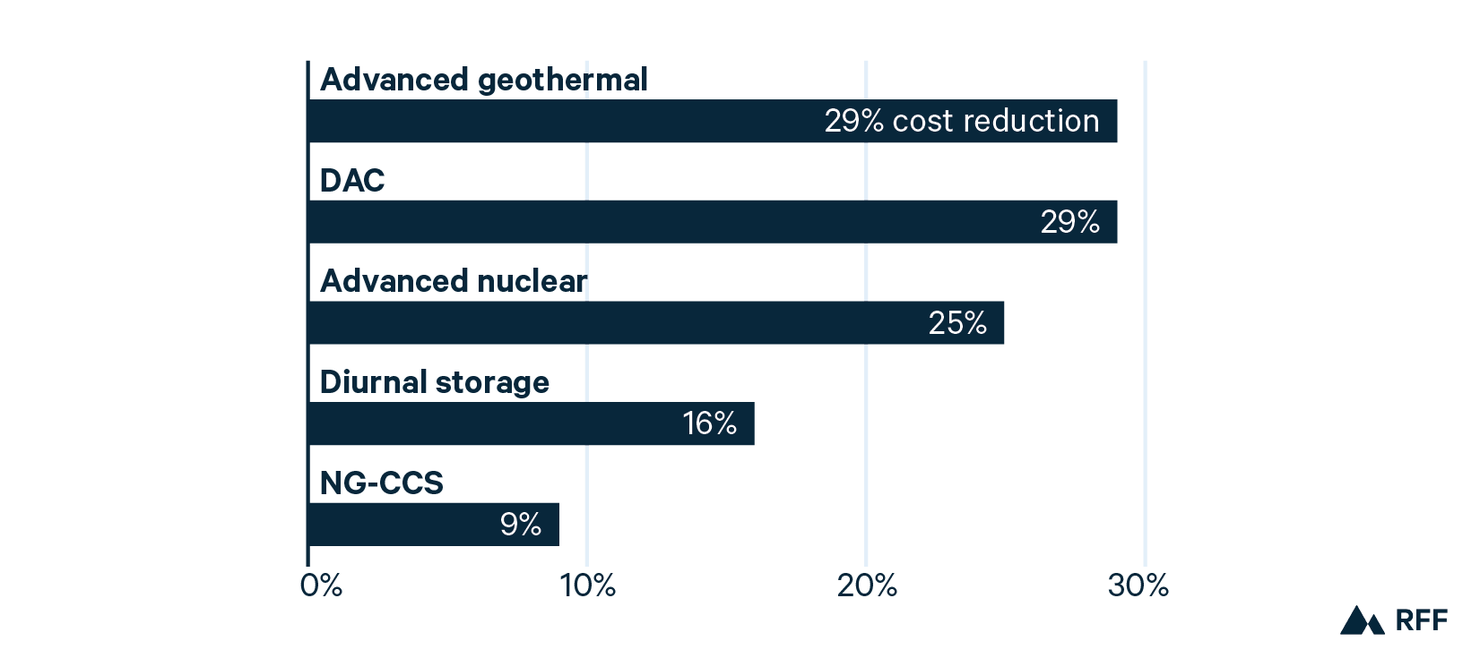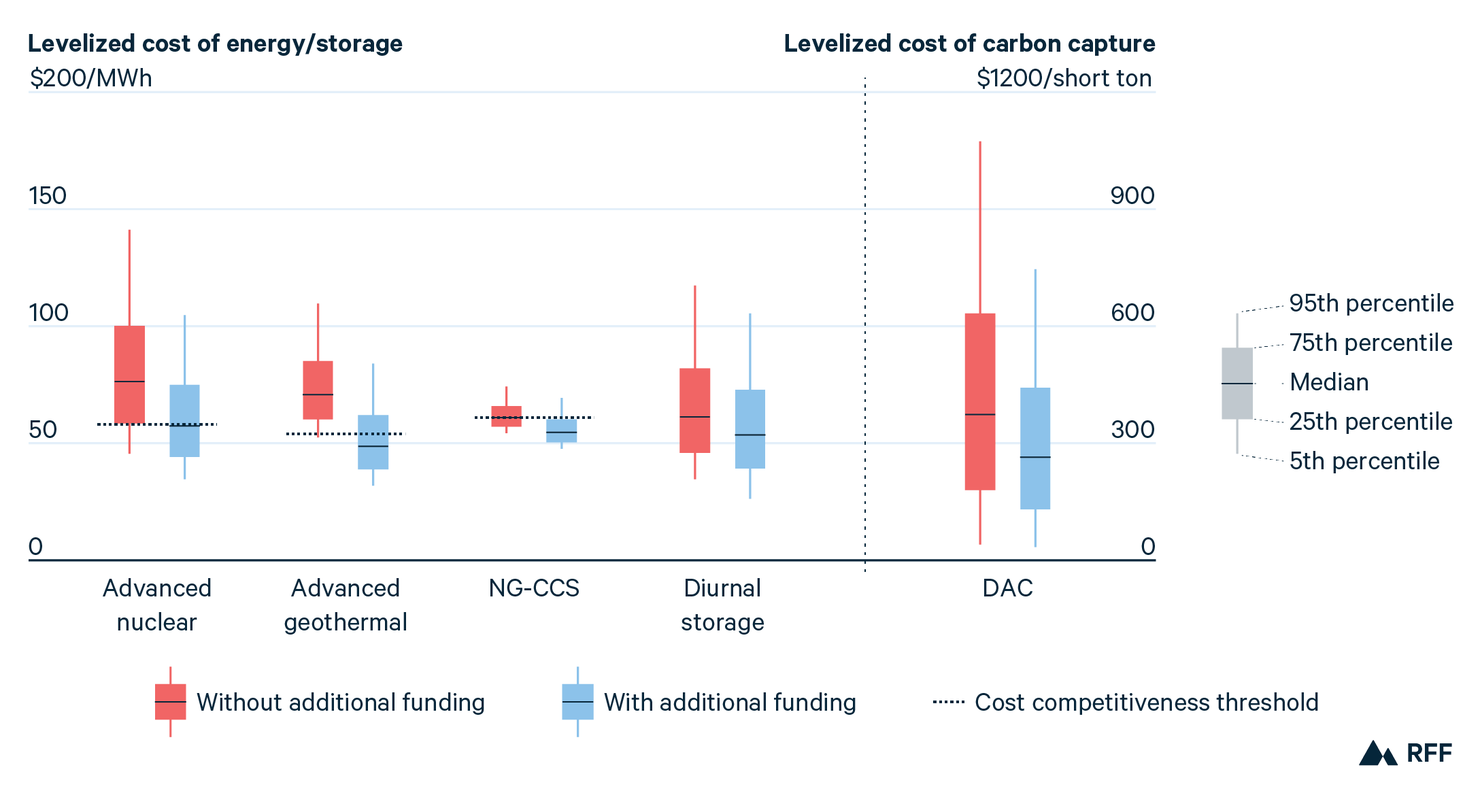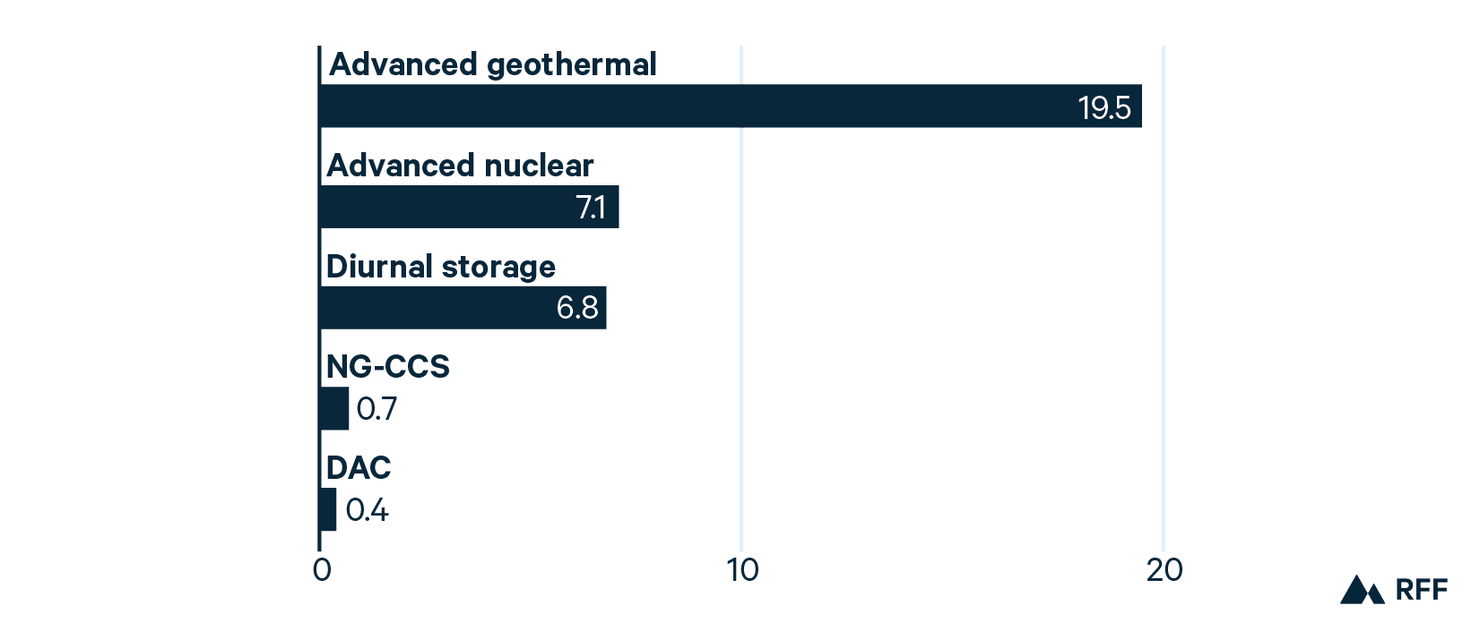The Value of Advanced Energy Funding: Analysis for Active Legislative Discussion
This issue brief summarizes the findings of a study that estimates some of the effects of proposed additional RD&D funding for five advanced clean energy technologies.
The benefits of additional research, development, and demonstration (RD&D) for advanced energy technologies are likely to greatly exceed the costs. The additional funding authorized by the Energy Act of 2020 for the five technologies we consider would generate projected societal benefits averaging $30 billion in present value per technology during 2040–2060. All dollar values in this brief are in 2020 dollars.
Twenty-six experts in advanced nuclear, advanced geothermal, energy storage, natural gas with carbon capture and sequestration (NG-CCS), and direct air capture (DAC) projected the effects of the additional RD&D funding on the future costs of the technologies. The experts expect the additional funding to reduce the costs of the technologies by 9–30 percent in 2035, compared with the case of no additional funding.
Applying the expert projections, we find that average power sector benefits of the added RD&D spending are likely to exceed costs by about 7 times without additional federal policies like a national clean energy standard. Benefits outside the power sector are likely to also be significant and would increase these ratios.
The estimated benefits of added RD&D funding are split mainly among lower electricity bills, health benefits, and climate benefits. Average annual electricity bill savings per household for each technology are about $14.
1. Context
President Trump signed the Energy Act of 2020 into law in December 2020, authorizing significant additional federal funding for the research, development, and demonstration (RD&D) of advanced clean energy technologies. The act earmarked funding for each of the technologies addressed in this study.
At the time of this writing, the US Senate has passed legislation that would fully fund or more than fully fund most of the physical infrastructure authorizations in the Energy Act of 2020 for the five technologies. That bill is the INVEST in America Act (H.R.3684), which is the bipartisan package that appropriates $550 billion in new funding for the nation’s infrastructure.
For those programs not receiving up-front appropriations in the INVEST in America Act, the House and Senate Energy and Water Development fiscal year 2022 appropriations bills marked up in each respective committee over the last two months include increases to program funding largely in line with, or higher than, the direction of the Energy Act of 2020 authorization.
This issue brief summarizes the findings of a late April study that estimates some of the effects of proposed additional RD&D funding for these five advanced clean energy technologies authorized in the Energy Act of 2020. Parts of the analysis were also done for a sixth technology, multiday energy storage. See the working paper for details. While the INVEST in America Act and the other appropriations bills mentioned above allocate somewhat different amounts than what is analyzed here, the brief still gives a good indication of how beneficial such investments are likely to be.
2. Summary of Study
Our study brings together results from two sources: technology cost projections from 26 technology cost experts, and simulations from past studies that calculate societal benefits of cost reductions for the technologies. The analysis estimates the benefit-to-cost ratio of additional funding for each technology assuming status quo national climate policy.
To assess future technology costs, the experts provided estimates for average lifetime costs of the technology they study in 2035, both with and without 10-year additional funding streams similar to those authorized under the Energy Act of 2020. The experts also estimated the increase in public and private RD&D spending from 2022 to 2031 that would result from such funding.
Societal benefits of additional funding were estimated by mapping the experts’ cost predictions onto simulation results in a study by Shawhan, Funke, and Witkin (2020), which models power-sector effects of all five technologies. This study uses the simulations to estimate annual power sector benefits in 2050 and assumes that they are representative of the annual benefits from 2040 to 2060.
Notably, several categories of benefits are not included here: benefits outside the electricity sector, benefits outside the years 2040–2060, US export profits, and benefits from the use of the advanced energy technologies outside the United States. Including these would likely increase the benefits of this funding. Also, the benefits are modeled under the conservative assumption that cost projections for 2035 would still apply in 2050. In reality, costs tend to decline over time, especially with use, and our detailed results in the study show that as the cost reductions grow larger, the central benefit estimates grow much larger.
3. Findings
3.1 Effects of Funding on Public and Private RD&D Spending
For all technologies studied, the experts estimate that the additional US government RD&D funding authorized in the Energy Act of 2020 (dark blue in Figure 1) will also increase US private RD&D spending (light blue) and foreign RD&D spending (lightest blue).
Figure 1. Projected Effect of Legislation on RD&D Spending If Fully Funded for 10 Years, FY 2022–FY2031 (billions of undiscounted 2020$)

3.2. Effects of Funding on Future Technology Costs
The experts’ responses indicate that 10-year RD&D funding (like that authorized by the Energy Act of 2020) would reduce the costs of each of the five analyzed technologies by an estimated 9–29 percent in 2035.
Figure 2 shows the average cost reductions expected for each technology. Figure 3 shows the same cost reductions plus the uncertainty about each one.
Figure 2. Estimated Average Cost Reductions in 2035 Due to 10-Year RD&D Funding

Figure 3 also shows cost-competitiveness thresholds calculated in Shawhan, Funke, and Witkin (2020). Cost-competitiveness is defined here as the cost needed for a technology to account for 1 percent of power generation.
Figures 2 and 3 provide a few key takeaways:
Experts expect the additional RD&D funding to reduce levelized costs of these technologies across the board, though by different amounts for different technologies.
The dashed lines, which show cost-competitiveness thresholds, provide context for these cost reduction estimates. Across all five technologies, the funding increases the likelihood of future cost-competitiveness with other, more traditional technologies, by 23 percentage points on average.
None of the technologies is certain to be cost-competitive, which is a reason to fund RD&D for multiple technologies.
Figure 3. Uncertainty Ranges for Levelized Cost, With and Without Added RD&D Funding

3.3 Benefits of Additional RD&D Funding
Additional funding for advanced energy technologies is likely to bring down the costs of the technologies, but what effect will these reduced costs have on society? Based on the results above and in previous simulations, the additional funding would generate estimated average societal benefits of $30 billion per technology — even without additional federal policies like a new national clean energy policy — assuming a 20-year benefit stream. These benefit totals are present values based on discounting the future benefits using a 3 percent real annual discount rate. All dollar values in this brief are in 2020 dollars.
All benefit-cost ratios include only benefits from the technology’s power sector use. Additionally, all of the benefit estimates in this study are central estimates for the types of benefits included in the study; the true benefits could be considerably higher or lower.
The benefits of the additional funding are, on average, several times as large as the costs. An estimated benefit-to-cost ratio—the benefits of funding per dollar of costs—is presented for each technology in Figure 4. Among the five analyzed technologies, average estimated benefits in the power sector are 6.9 times greater than the public and private costs. The estimated benefits of additional funding are more than five times the cost for three of the five technologies.
Figure 4. Estimated Benefit-to-Cost Ratios from 10 Years of RD&D Funding

The two carbon capture technologies have low benefit-to-cost ratios because they are little used in the absence of any climate policies. Our full report finds that if stringent decarbonization goals were in place, they would be used and highly beneficial.
The estimated benefits of added RD&D funding are split mainly among lower electricity bills, health benefits, and climate benefits. Electricity bill savings amount to an average of approximately $14 per household per year for each technology.
Our research indicates that the benefits per dollar of RD&D funding for a given technology can actually increase with additional funding. That implies that additional funding beyond what is authorized in the Energy Act of 2020 could potentially result in similarly large or even larger benefit-to-cost ratios.
4. Conclusions
Experts believe that increased US federal funding will reduce the costs of these five advanced energy technologies, partly through spillover effects on private and international RD&D spending.
Even without any new national clean energy policy, ten years of federal RD&D funding at the levels authorized in the Energy Act of 2020 would create an average estimated $30 billion in future societal benefits per technology. The average estimated benefit-to-cost ratio is 7 to 1.
NG-CCS and DAC bring down this average. Under our modeling and assumptions, RD&D funding for them would pay off richly within the US power sector only if there were also sufficient federal or state policy incentives for their use.







